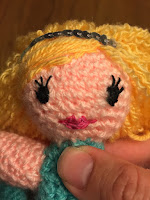Please don't be offended, it's all said in fun ;)
(Personally - I think I am all seven at one point or another!)
1. The Hoarder
The hoarder is a crochet being of immense need, and a great unwillingness to part with, various yarn titbits that have accumulated in their stash. Sometimes hoarders just like to look/smell/feel the yarn in their stash, and dream with anticipation of all the projects they could make, but never will.
Example: my favourite yellow was running out so I refused to use it in any projects. It stayed in my yellow/orange yarn stash, getting considerably tangled and evermore frayed. Until I threw it out.
Note: *shifty eyes* but I didn't.
Some say it is still in that stash, but I will probably never know as I have stashed more yarn on top of it.
Note: *shifty eyes* but I didn't.
Some say it is still in that stash, but I will probably never know as I have stashed more yarn on top of it.
2. The Yarn Snob
The hand-dyed, grass-fed, free-range, locally shorn, naturally coloured pure-merino-alpaca-blend buyer, who then uses it to crochet on their organic, free-trade Chinese-bamboo crochet hook. These people often start a sentence with,
'Oh, I found this yarn at a local farmers market...' And go on to describe its qualities in detail. Don't tell them you use Kmart acrylic. They pretend not to judge, but they are judgy-judgers.
The Vegans of the Crochet world.
(Note: I am too poor to afford this $25 a skein yarn, hence, I hate them on principle.)
The Vegans of the Crochet world.
(Note: I am too poor to afford this $25 a skein yarn, hence, I hate them on principle.)
3. The Juggler
The Juggler generally has several half finished projects going on at once. Often two or more are within arms reach of their crocheting corner. Jugglers are akin to butterflies, with a four second memory for what they are currently doing, replaced by a new pattern/yarn/stitch that 'I'll just quickly try...'. Many of these poor projects never find homes, only to be rediscovered months or years later when the Juggler is clearing out the craft cupboard.
*Cough* True Story *Cough*
4 The Perfectionist
Many plans, no crochet.
Perfectionists tend to frog their work when it isn't perfect, and start again.
and again.
and again.
They grow considerably more stressed if their counting is interrupted or, heaven forbid, they added an extra stitch somewhere along the line (Don't fib, we've all done it!). Don't ask a planner when they will be starting their crochet project because the answer will inevitably be a change of subject, a huge rant about the yarn, or a weak excuse like 'when it's ready'.
Truth: it's never ready.
and again.
and again.
They grow considerably more stressed if their counting is interrupted or, heaven forbid, they added an extra stitch somewhere along the line (Don't fib, we've all done it!). Don't ask a planner when they will be starting their crochet project because the answer will inevitably be a change of subject, a huge rant about the yarn, or a weak excuse like 'when it's ready'.
Truth: it's never ready.
5. The Expert
Often the quiet achiever of the group, the expert can be found you tubing new stitches, yarn reviews, and reading 'Crochet Weekly' on their perfect, doily-covered coffee table. Not to be confused with the 'loud know-it-all' who attempts to teach everyone how to crochet but doesn't know their chain stitch from a crocodile stitch, the expert actually is very good with their hooking, not that they would admit it or give you tips. That's why you probably want to slap their smug little crochet-collared face. (Please teach me!!!)
6 The Newbie
The newbie's favourite phrase involves a few expletives, and you can usually find them crocheting a slightly-longer-on-one-end-oh-God-how-did-this-happen scarf. They can be spotted buying the wrong yarn for their chosen project, and using a hook that is far too big/small. Tension? What's tension?
The newbie has two choices in their crocheting path: fight or flight. They can suffer through newbie-ism and one day become the over-smug expert, or give up on crochet and take up the much less useful craft of scrap booking.
(Keep on truckin', Newbie! We've all been there!)
The newbie has two choices in their crocheting path: fight or flight. They can suffer through newbie-ism and one day become the over-smug expert, or give up on crochet and take up the much less useful craft of scrap booking.
(Keep on truckin', Newbie! We've all been there!)
7 The Over-Achiever.
 |
| image: http://poppyandbliss.com/ How beautiful! |
Too many pattern books, several completed projects beautifully wrapped in hand printed ribbon for your second cousins kids at Christmas, and often a cat. The overachiever enjoys completing projects, even if it means an all nighter. Or an all dayer. One of their most enjoyed moments is presenting their friends with afghans and coaster sets and saying 'oh, it was nothing.'
News flash over-achiever; you're breeding a culture of gift receivers who don't appreciate the 50 hours you put in to that blanket. Stop ruining it for the rest of us!
On that note, can you make me a...
Hope this made you smile ;)
Rhonie xxx
Hope this made you smile ;)
Rhonie xxx
















































